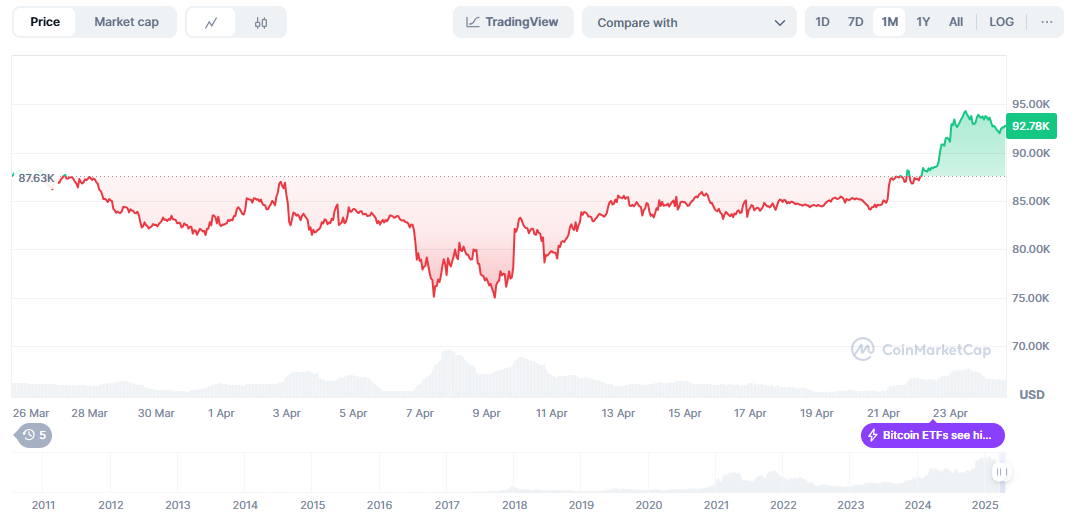Impact of Upcoming USA Tariffs on Bitcoin and Cryptocurrency Market
New presidency, new tariff rates. The US president, Donald Trump, started his presidency with a bang, from stronger support for cryptos to massive government changes, cutbacks, and most recently, tariffs.
Amidst the confusion and rapid changes having a major impact on foreign policy, diplomacy, global economy, and relations, many of us are left wondering, how will these tariffs impact cryptocurrencies?
The short answer is yes, there will be changes, and new articles are popping up every few hours with the latest updates. The topic is extremely deep and multilayered, so we’ll break down the key topics only, exploring the main factors that can potentially affect the global cryptocurrency market.
Table of contents
Covering the Basics: What are Tariffs?
Tariffs are essentially taxes that governments impose on all imported goods and services in order to regulate trade between countries by making foreign goods more expensive. This encourages people to “buy local” from domestic producers.
When it comes to explaining how tariffs work, they can be either fixed, having a set amount per item, or ad valorem, which is essentially setting a percentage of the item’s value. The main idea behind tariffs is to protect domestic industries from foreign competition, generate more revenue, and sometimes retaliate against unfair trade practices. Additionally, tariffs can also be used for better economic security.
While tariffs can support local jobs and industries, encouraging domestic manufacturing, they can also lead to higher prices for consumers and trade tensions between countries. That’s why most economists generally agree that high tariffs can have negative effects on economic growth. This is already widely documented and backed by many historical examples.
Taking a Look at the Famous 2025 Trump Tariffs
In February 2025, President Trump started his presidency with a wave of changes, including tariffs. Right off the bat, Trump imposed a 10% universal tariff on nearly all imports to the United States, with higher rates for specific countries.
In one notable case, Chinese imports faced a cumulative tariff rate of 145% due to previous tariff rate increases. Canada and Mexico, on the other hand, were subjected to 25% tariffs on most goods, excluding energy, which faced a 10% tariff.
Moreover, Executive Order 14245 imposed a 25% tariff on all goods from countries importing Venezuelan oil. However, this wasn’t the end of the tariff wave. The Trump administration continued to change its tariff policy multiple times, adding to the confusion on a global scale.
On April 2, 2025, dubbed “Liberation Day,” the U.S. introduced reciprocal tariffs ranging from 20% to 50% on imports from over 100 countries, including key trading partners like China, Vietnam, and India. A 90-day pause on tariffs was later announced for non-retaliating countries, but a baseline 10% tariff remained in place. Though, notably, this didn’t really aid foreign policy and relations.
How Do Tariffs Impact the Economy on a Global Scale?
Not surprisingly, world trade was shaken to its core. The first tariff announcement may have come out in February, but the process of enacting them is still taking place, particularly when we take into account the constant changes, which only increase further confusion. The instability is already impacting global trade and the crypto markets.
U.S. Economy & Global Trade Deal
While the US president announced tariffs as a way to elevate the US economy in the long run, it’s not exactly showing great results at the moment. A sudden price increase on all foreign goods and products is expected, but it doesn’t mean that it’s well-received, particularly given the already increasing grocery prices.
On a national level, many US businesses have benefited from doing business with foreign producers in the past, often acquiring parts or other necessities. However, when the US government announced tariffs on products imported from other countries, those foreign goods became more expensive for US businesses to buy.
So, if a US business were buying parts, raw materials, or finished goods from another country like China, they would now have to pay more for the same items. For example, small appliance makers like Hamilton Beach and retail chains like Dollar Tree reported double-digit cost increases in Q1 2025 due to 25–35% tariffs on Chinese goods.
The stock market changes are a separate topic on their own, and we won’t be touching them in this article. However, the S&P 500 saw a 7.3% drop in the two weeks following the February 2025 announcement, while bond yields soared amid investor fears of persistent inflation. You can already imagine how this can and already does reflect on the crypto market, but we’ll get into that in a bit.
How Will US Tariffs Impact Foreign Affairs?
From what we can observe now, the US 2025 tariff campaign has strained US relations with foreign governments, to which other countries are either answering with their own tariffs or discussing other retaliation actions.
- China: In response to the whopping 145% tariffs, China imposed retaliatory duties on some US goods. Beijing has also pivoted toward strengthening trade ties with the EU, ASEAN, and Latin American markets to reduce dependency on U.S. trade routes.
- European Union: While most EU countries were temporarily exempt from the highest tier tariffs, leaders in Brussels have warned of retaliatory measures. French President Emmanuel Macron even went as far as to label the tariffs illegal.
- Canada: Canadian Prime Minister Justin Trudeau condemned the move as a violation of trade commitments and announced a reciprocal 20% tariff on US dairy, auto, and steel products.
Tariffs & Crypto, What Will Happen?
Now, it’s obvious that the US tariffs are seriously affecting global trade relations, but when it comes to cryptos, the situation becomes even murkier. Originally, cryptocurrencies were created to function outside of traditional finance, decentralizing it and, in many ways, democratizing financial inclusion, especially in developing countries that don’t have access to banking services.
That being said, the global inclusion, coupled with the fact that cryptocurrencies are digital assets, not backed by assets, governments, or central banks, makes cryptos inevitably susceptible to major investment trends and changes to them.
As Binance’s CEO Richard Teng stated, “The resurgence of trade protectionism is introducing significant volatility across global markets – and crypto is no exception. In the short term, this kind of macro uncertainty tends to trigger a risk-off response, with investors pulling back as they wait to see how things unfold around growth, policy, and trade.
Looking further ahead, though, this environment could also accelerate interest in crypto as a non-sovereign store of value. Many long-term holders continue to view Bitcoin and other digital assets as resilient during periods of economic stress and shifting policy dynamics.”

1. Market Volatility and Risk-Off Sentiment
When Trump proposed a 50% tariff on Chinese imports, the crypto market saw a sharp drop in early April 2025, with Bitcoin falling to $74,500 and ETH losing over 20%, though it did slightly recover following the 90-day tariff pause. Additionally, the increased tariffs on Chinese imports affected the cost of cryptocurrency mining equipment like GPUs, used by ASIC miners.
2. Increased Appeal as an Inflation Hedge
Historically, during times of economic instability, investors have shown a tendency to avoid speculative and new projects in favor of liquidity and defensive assets. However, seeing as how heavily the stock market was affected by the tariff proposition, with examples like the S&P 500 Index falling more than 10% in just two days and the Dow Jones Industrial Average dropping over 7%, cryptocurrencies have the potential to act like a hedge.
Sure, short-term volatility has shaken investors’ confidence in digital currencies, but long-term crypto sentiment is shifting towards a more favorable sentiment. US consumers are actively exploring decentralized alternatives. In fact, the on-chain activity on the Lightning Network saw a 17% spike in April compared to March, according to Glassnode. That’s why many are actually avoiding to sell Bitcoin as it’s seen as a strong store of value.
3. Stablecoins & Cross-Border Payments
Stablecoins have already shown increased interest before the tariff announcement, but after the proposal in February, there was a significant rise in stablecoin settlement volumes, especially in Asia and Latin America. Tether (USDT) and USD Coin (USDC) have seen a 24% increase in transfer volume across Latin America since the start of Q2 2025.
Moreover, on March 18, 2025, Italy’s Economy Minister Giancarlo Giorgetti stated that the US policy on stablecoins offers EU citizens an attractive payment method for cross-border transactions, and this could potentially trigger more concern than trade tariffs.
4. Regulatory Crosscurrents
Although the growing interest in cryptos is also resulting in more regulations, which in essence work to both regulate and encourage crypto adoption, the Trump administration’s policies have thrown a wrench in the works.
Now, the Securities and Exchange Commission (SEC) and Commodity Futures Trading Commission (CFTC) remain wary of endorsing crypto. At the same time, some Republican lawmakers in the US are advocating for clearer “digital asset neutrality” legislation to protect crypto exchanges and stablecoin issuers from potential penalties tied to future tariff-related sanctions or banking restrictions.
5. Mining & Infrastructure Impacts
Tariffs have also had an indirect but significant impact on the crypto mining industry. Specifically, crypto miners who are based in the US, source most of their hardware from Chinese manufacturers like Bitmain and Canaan, are now facing a 15–20% price increase due to tariffs on ASICs and GPUs.
If the situation doesn’t change, the crypto industry could shift operations to more cost-efficient and tariff-neutral countries like Paraguay, Kazakhstan, and regions of Africa.
On another note, the increased taxes on hardware could potentially accelerate cryptocurrencies’ move towards more environmentally-friendly solutions, although it’s still just speculation. Either way, it’s not the first hiccup the crypto market is facing, and it will likely not be the last, and this only adds to the adaptability of decentralized finance.
Staying Ahead with Paybis
Paybis is a global cryptocurrency exchange founded in 2014, specializing in fast, secure fiat-to-crypto and crypto-to-fiat transactions. Users can easily buy and sell Bitcoin, Ethereum, and other digital assets using credit/debit cards, bank transfers, and e-wallets through an intuitive, user-friendly platform.
With operations in over 180 countries, Paybis prioritizes security and regulatory compliance, following strict AML/KYC procedures. Offering 24/7 customer support and competitive exchange rates, it has become a trusted choice for both beginners and experienced crypto traders. So, no matter what uncertainties may come, you can be sure we’ll continue providing reliable crypto services.
Conclusion
Making any assumption, especially one connected with cryptos, at this time is difficult, further made more complex by the continuous tariff changes by the Trump administration. What we can say is that the World Trade Organization and the International Trade Commission are on their toes, with countries now actively discussing steps to take in response to such tariffs.
When it comes to crypto prices, the situation is as clear as it ever was. Sure, the tariffs add another layer of uncertainty, but cryptos are already subject to many other factors that contribute to their volatility. On the upside, this is also a major development factor that encourages decentralized finance to advance.
FAQ
Will crypto prices increase with US tariffs?
As the global stock market continues to experience uncommon disruption, investors are turning to established cryptocurrencies like Bitcoin and others. While cryptos aren’t exactly shielded from the repercussions of the tariffs, cryptos are still showing potential in terms of asset diversification. However, it’s still too early to state how the situation will change at this time.
At Paybis, we’re focused on bringing you the most relevant information so you can buy Bitcoin with credit card easily and hassle-free, whenever you need.
How much are tariffs from China to the US?
The US tariffs are meant to discourage the consumption of foreign goods, focusing on domestic products. But the aftershock of the tariff announcement has left many US citizens, businesses, and foreign parties in shock due to the significantly increased prices and taxes.
As an example, in response to U.S. tariffs, China has enacted the following measures, increasing its tariffs on US goods to 84%. Additionally, China also announced it would reduce imports of American films.
Who pays tariffs in the USA?
In the United States, tariffs are taxes imposed on foreign imported goods. While foreign exporters may adjust their prices in response to the new tariffs, the immediate financial burden will actually fall on US importers, businesses of different sizes.
These businesses would then pass on the increased costs to consumers by increasing prices, making consumers pay more.
Did tariffs cause the great depression?
Tariffs didn’t cause the Great Depression, but they did have an impact on it. The Smoot-Hawley Tariff Act of 1930 raised U.S. tariffs on many different imports, which led to retaliatory tariffs from other countries. And as we all know, that didn’t go so great.
Disclaimer: Don’t invest unless you’re prepared to lose all the money you invest. This is a high‑risk investment and you should not expect to be protected if something goes wrong. Take 2 mins to learn more at: https://go.payb.is/FCA-Info


